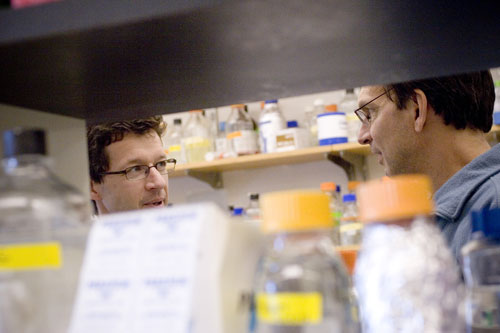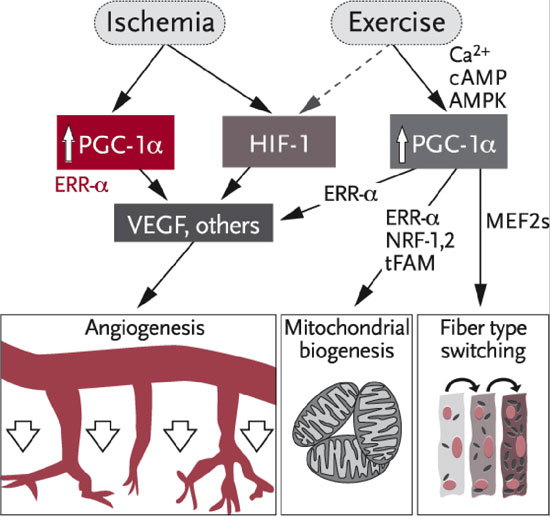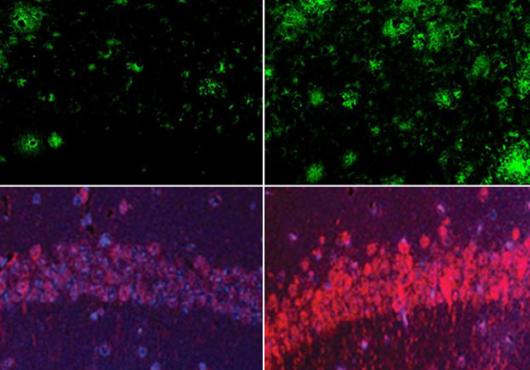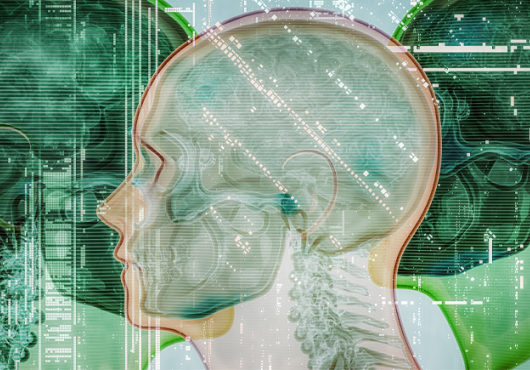One of the most intensive pursuits in medical science is the hunt for ways to control the formation of new blood vessels. This process of angiogenesis has been called the common denominator of disease because of its influence on many different conditions, from cancer to heart disease to tissue injury and degeneration. Millions of patients stand to benefit from angiogenic therapies.

But building new vessels or tearing them down is not a simple process. There are at least 50 known factors in the body that govern vessel formation, and harnessing them can be tricky. Several therapies targeting a single though central factor have failed, for example, because the new vessels remain leaky and immature. Researchers are now looking for targets that coordinate multiple angiogenic factors.
That is why when Bruce Spiegelman, HMS professor of cell biology at the Dana–Farber Cancer Institute, and his colleague Zoltan Arany, HMS instructor in medicine at Beth Israel Deaconess Medical Center, recognized that a gene known for regulating metabolism also behaves like the conductor of a grand angiogenic orchestra, they were pleasantly surprised.
This gene, PGC-1 alpha, “turns on a whole program of angiogenesis,” said Spiegelman. “It’s one of nature’s ways of turning on angiogenesis. It puts things in the right place and in the right balance.”
The researchers are quick to point out that another angiogenic orchestral conductor of sorts, hypoxia-inducible factor (HIF), also exists and is well understood. What they have found in PGC-1 alpha is a second, completely independent pathway to new blood vessel growth. They describe their discovery in the Feb. 21 Nature.
To build mature vessels, “we need to recapitulate what goes on in the body, to find orchestrators that bring in different molecules at different times. PGC-1 alpha is definitely one of these,” said Rakesh Jain, the A. Werk Cook professor of radiation oncology (tumor biology) at Massachusetts General Hospital. The discovery, he added, “opens up many doors” because it makes a molecular connection between metabolism and angiogenesis, two fundamental and interrelated biological processes with wide influence.
Expanding Regulatory RolesSpiegelman discovered PGC-1 alpha 10 years ago and identified it as a key regulator of metabolic processes such as energy production and respiration. He and HMS professor of cell biology Alfred Goldberg later uncovered its role in protecting against muscle atrophy. This most recent study began when Spiegelman and Arany decided to explore the gene’s role in ischemia, resulting when tissue is deprived of oxygen and nutrients. The condition can occur, for example, when a blocked artery cuts off the blood supply to an organ or limb.
As a cardiologist, Arany approached this study with heart attacks in mind. In heart disease, there is “no worse metabolic disaster than ischemia,” which can lead to heart attack, he said. “So what happens to this big metabolic regulator”—PGC-1 alpha—“during a big metabolic disaster?”
In their first experiments, they deprived cultured myotubes of oxygen and nutrients for several hours. Genetic screening revealed that PGC-1 alpha expression levels soared 10-fold in these cells and remained elevated until nutrients were restored. They observed similar results in every cell line they tested.
Seeing PGC-1 alpha respond to hypoxia in a way similar to the other angiogenic regulator HIF tipped them off that PGC-1 alpha might play a role in angiogenesis. “We were fishing in the right waters,” said Spiegelman of their serendipitous discovery. “We just weren’t looking for this particular fish.”
Pathway PlayersTo determine what other factors PGC-1 alpha cues downstream, they infected cultured myotubes with a virus expressing either PGC-1 alpha or green fluorescent protein as a control. PGC-1 alpha expression led to a fourfold increase in the expression of vascular endothelial growth factor (VEGF), a central figure in new blood vessel growth. It led to increased expression of PDGF-BB, which recruits the structure-providing mural cells that are often underrepresented in leaky, immature vessels. It also boosted angiopoietin-2, which encourages new vessels to bud and spring from existing vessels. Further, the researchers found that PGC-1 alpha co-activates estrogen-related receptor alpha (ERR-alpha) to stimulate VEGF expression.

With this evidence in hand, the team examined PGC-1 alpha’s role as a conductor of angiogenesis in vivo by comparing wild-type control mice to knockout mice lacking PGC-1 alpha. They severed blood flow through the femoral artery to a hind limb in both groups of animals to simulate ischemia. The wild-type mice grew new blood vessels over a period of weeks and gradually restored blood flow to the limb. In the knockout mice, however, blood flow remained severely restricted.
“This study raises the dream that one might design drugs that act through this pathway to turn angiogenesis on or off,” said Arany. PGC-1 alpha is a very attractive target because it also has therapeutic potential in several other arenas. For instance, PGC-1 alpha–knockout mice tend to exhibit neurodegeneration, suggesting that the gene protects against this condition. The same holds for cardiovascular disease, as well as muscle atrophy.
But there is more work to be done to determine if PGC-1 alpha is a viable target for drugs. As a start, Spiegelman and Arany embarked two years ago, along with collaborators at the Broad Institute and Novartis, on a mission to identify molecules that trigger the gene. Their results are not yet published, but early results are promising.
“In science, what we do is find orchestrators,” teasing out from the complexity of cellular signaling those “points in the system that you can tweak and make big things happen,” said Arany. “It’s nice to find such orchestrators. PGC-1 alpha seems to be one of them.”


